Interface Direct Shear Tests on JEZ-1 Mars Regolith Simulant
Abstract
:1. Introduction
2. Materials
2.1. JEZ-1 Mars Regolith Simulant
2.2. Steel Plate
3. Experimental Setup
3.1. Oedometer Test
3.2. Interface Direct Shear Test
4. Results
4.1. Oedometric Response
4.2. Direct Shear Tests
4.3. Interface Direct Shear Response
5. Conclusions
- The compressibility and swelling index of JEZ-1 are quite low;
- Both the peak and residual cohesion of JEZ-1 are <4 kPa. The peak (φpeak) and critical (φcv) internal friction angles are 40.6° and 39.7°, respectively;
- The adhesion of the interface between JEZ-1 and smooth/rough steel are lower than 5 kPa;
- The peak interface friction angles (δpeak) are 18.9° and 36.2°, and the residual interface friction angles (δcv) are 16.7° and 33.2°, respectively, for the smooth and rough interfaces;
- The interface friction angles (δ) are lower than the internal friction angles (φ) of JEZ-1. The δ gets close to the φ when increasing the interface roughness.
Author Contributions
Funding
Institutional Review Board Statement
Informed Consent Statement
Data Availability Statement
Acknowledgments
Conflicts of Interest
References
- Allen, C.C.; Morris, R.V.; Jager, K.M.; Golden, D.; Lindstrom, D.J.; Lindstrom, M.M.; Lockwood, J.P. Martian regolith simulant JSC Mars-1. In Proceedings of the Lunar and Planetary Science Conference, Houston, TX, USA, 16–20 March 1998; p. 1690. [Google Scholar]
- Peters, G.H.; Abbey, W.; Bearman, G.H.; Mungas, G.S.; Smith, J.A.; Anderson, R.C.; Douglas, S.; Beegle, L.W. Mojave Mars simulant—Characterization of a new geologic Mars analog. Icarus 2008, 197, 470–479. [Google Scholar] [CrossRef]
- Cannon, K.M.; Britt, D.T.; Smith, T.M.; Fritsche, R.F.; Batcheldor, D. Mars global simulant MGS-1: A Rocknest-based open standard for basaltic martian regolith simulants. Icarus 2019, 317, 470–478. [Google Scholar] [CrossRef] [Green Version]
- Clark, J.; Archer, P.; Gruener, J.; Ming, D.; Tu, V.; Niles, P.; Mertzman, S. JSC-Rocknest: A large-scale Mojave Mars Simulant (MMS) based soil simulant for in-situ resource utilization water-extraction studies. Icarus 2020, 351, 113936. [Google Scholar] [CrossRef]
- Perko, H.A.; Nelson, J.D.; Green, J.R. Mars soil mechanical properties and suitability of Mars soil simulants. J. Aerosp. Eng. 2006, 19, 169–176. [Google Scholar] [CrossRef]
- Iai, M.; Luna, R. Direct shear tests on JSC-1A lunar regolith simulant. J. Aerosp. Eng. 2011, 24, 433–441. [Google Scholar] [CrossRef]
- David Frost, J.; Martinez, A. Interface Shear Response of JSC-1A, GRC-3, and JSC-Mars1 Regolith Simulants. J. Aerosp. Eng. 2018, 31, 04018003. [Google Scholar] [CrossRef]
- Fujikawa, T.; Newson, T.; Ahmed, A.; Safdar, M. Assessment of the Geo-Mechanical Properties of Mojave Mars Simulant-1 (MMS-1) Soil. In Proceedings of the Geotechnical Engineering in the XXI Century: Lessons Learned and Future Challenges: Proceedings of the XVI Pan-American Conference on Soil Mechanics and Geotechnical Engineering (XVI PCSMGE), Cancun, Mexico, 17–20 November 2019; p. 268. [Google Scholar]
- Sullivan, R.; Anderson, R.; Biesiadecki, J.; Bond, T.; Stewart, H. Cohesions and friction angles of Martian regolith from MER wheel trenches and wheel scuffs. In Proceedings of the Lunar and Planetary Science Conference, Woodlands, TX, USA, 1–5 March 2010; p. 1879. [Google Scholar]
- Uesugi, M.; Kishida, H. Frictional resistance at yield between dry sand and mild steel. Soils Found. 1986, 26, 139–149. [Google Scholar] [CrossRef] [Green Version]
- Vasilescu, A.-R. Design and Execution of Energy Piles: Validation by In-Situ and Laboratory Experiments. Ph.D. Thesis, École centrale de Nantes, Nantes, France, 2019. [Google Scholar]
- Maghsoodi, S.; Cuisinier, O.; Masrouri, F. Thermo-mechanical behaviour of clay-structure interface. In Proceedings of the E3S Web of Conferences, Glasgow, UK, 25 June 2019; p. 10002. [Google Scholar]
- Maghsoodi, S.; Cuisinier, O.; Masrouri, F. Comportement thermo-mécanique de l’interface sable-structure. In Proceedings of the 17th European Conference on Soil Mechanics and Geotechnical Engineering, Reykjavík, Iceland, 1–6 September 2019. [Google Scholar]
- Maghsoodi, S. Thermo-Mechanical Behavior of Soil-Structure Interface under Monotonic and Cyclic Loads in the Context of Energy Geostructures. Ph.D. Thesis, Université de Lorraine, Nancy, France, 2020. [Google Scholar]
- Yin, K. Influence of Clay Fraction on the Mechanical Behavior of a Soil-Concrete Interface. Ph.D. Thesis, École Centrale de Nantes, Nantes, France, 2021. [Google Scholar]
- Hu, L.; Pu, J. Testing and modeling of soil-structure interface. J. Geotech. Geoenviron. Eng. 2004, 130, 851–860. [Google Scholar] [CrossRef]
- Yin, K.; Liu, J.; Vasilescu, A.-R.; Di Filippo, E.; Othmani, K. A Procedure to Prepare Sand–Clay Mixture Samples for Soil–Structure Interface Direct Shear Tests. Appl. Sci. 2021, 11, 5337. [Google Scholar] [CrossRef]
- Vasilescu, A.R.; Fauchille, A.-L.; Dano, C.; Kotronis, P.; Manirakiza, R.; Gotteland, P. Impact of temperature cycles at soil-concrete interface for energy piles. In Proceedings of the International Symposium on Energy Geotechnics, Lausanne, Switzerland, 25–28 September 2018; pp. 35–42. [Google Scholar]
- Vasilescu, R.; Yin, K.; Fauchille, A.-L.; Kotronis, P.; Dano, C.; Manirakiza, R.; Gotteland, P. Influence of thermal cycles on the deformation of soil-pile interface in energy piles. In Proceedings of the E3S Web of Conferences, Glasgow, UK, 25 June 2019; p. 13004. [Google Scholar]
- Vaid, Y.P.; Sivathayalan, S.; Stedman, D. Influence of specimen-reconstituting method on the undrained response of sand. Geotech. Test. J. 1999, 22, 187–195. [Google Scholar]
- Sze, H.; Yang, J. Failure modes of sand in undrained cyclic loading: Impact of sample preparation. J. Geotech. Geoenviron. Eng. 2014, 140, 152–169. [Google Scholar] [CrossRef] [Green Version]
- Raghunandan, M.; Juneja, A.; Hsiung, B. Preparation of reconstituted sand samples in the laboratory. Int. J. Geotech. Eng. 2012, 6, 125–131. [Google Scholar] [CrossRef]
- Kuerbis, R.; Vaid, Y. Sand sample preparation-the slurry deposition method. Soils Found. 1988, 28, 107–118. [Google Scholar] [CrossRef] [Green Version]
- Wang, S.; Luna, R.; Stephenson, R.W. A slurry consolidation approach to reconstitute low-plasticity silt specimens for laboratory triaxial testing. Geotech. Test. J. 2011, 34, 288–296. [Google Scholar]
- Bendahmane, F.; Marot, D.; Alexis, A. Experimental parametric study of suffusion and backward erosion. J. Geotech. Geoenviron. Eng. 2008, 134, 57–67. [Google Scholar] [CrossRef]
- Krage, C.P.; Price, A.B.; Lukas, W.G.; DeJong, J.T.; DeGroot, D.J.; Boulanger, R.W. Slurry Deposition Method of Low-Plasticity Intermediate Soils for Laboratory Element Testing. Geotech. Test. J. 2020, 43, 1269–1285. [Google Scholar] [CrossRef]
- Yin, K.; Fauchille, A.-L.; Othmani, K.; Sciarra, G.; Kotronis, P.; Benoit, Y.; Bertrand, F.; Branchu, S. Influence of sample preparation on the multi scale structure of sand-clay mixtures. In Proceedings of the E3S Web of Conferences, Glasgow, UK, 25 June 2019; p. 01007. [Google Scholar]
- Maghsoodi, S.; Cuisinier, O.; Masrouri, F. Thermal effects on one-way cyclic behaviour of clay-structure interface. In Proceedings of the E3S Web of Conferences, La Jolla, CA, USA, 18 November 2020; p. 05001. [Google Scholar]
- Zeng, X.; He, C.; Oravec, H.; Wilkinson, A.; Agui, J.; Asnani, V. Geotechnical properties of JSC-1A lunar soil simulant. J. Aerosp. Eng. 2010, 23, 111–116. [Google Scholar] [CrossRef]
- Arvidson, R.E.; Anderson, R.; Bartlett, P.; Bell, J.; Blaney, D.; Christensen, P.R.; Chu, P.; Crumpler, L.; Davis, K.; Ehlmann, B. Localization and physical properties experiments conducted by Spirit at Gusev Crater. Science 2004, 305, 821–824. [Google Scholar] [CrossRef] [PubMed] [Green Version]
- Arvidson, R.; Anderson, R.; Bartlett, P.; Bell, J.; Christensen, P.; Chu, P.; Davis, K.; Ehlmann, B.; Golombek, M.; Gorevan, S. Localization and physical property experiments conducted by Opportunity at Meridiani Planum. Science 2004, 306, 1730–1733. [Google Scholar] [CrossRef] [PubMed]
- Pra-ai, S. Behaviour of soil-structure interfaces subjected to a large number of cycles. Application to Piles. Ph.D. Thesis, Université de Grenoble, Grenoble, France, 2013. [Google Scholar]
- Martinez, A.; Stutz, H.H. Rate effects on the interface shear behaviour of normally and overconsolidated clay. Géotechnique 2019, 69, 801–815. [Google Scholar] [CrossRef]
- Tsubakihara, Y.; Kishida, H.; Nishiyama, T. Friction between cohesive soils and steel. Soils Found. 1993, 33, 145–156. [Google Scholar] [CrossRef] [Green Version]
- Chen, X.; Zhang, J.; Xiao, Y.; Li, J. Effect of roughness on shear behavior of red clay-concrete interface in large-scale direct shear tests. Can. Geotech. J. 2015, 52, 1122–1135. [Google Scholar] [CrossRef]

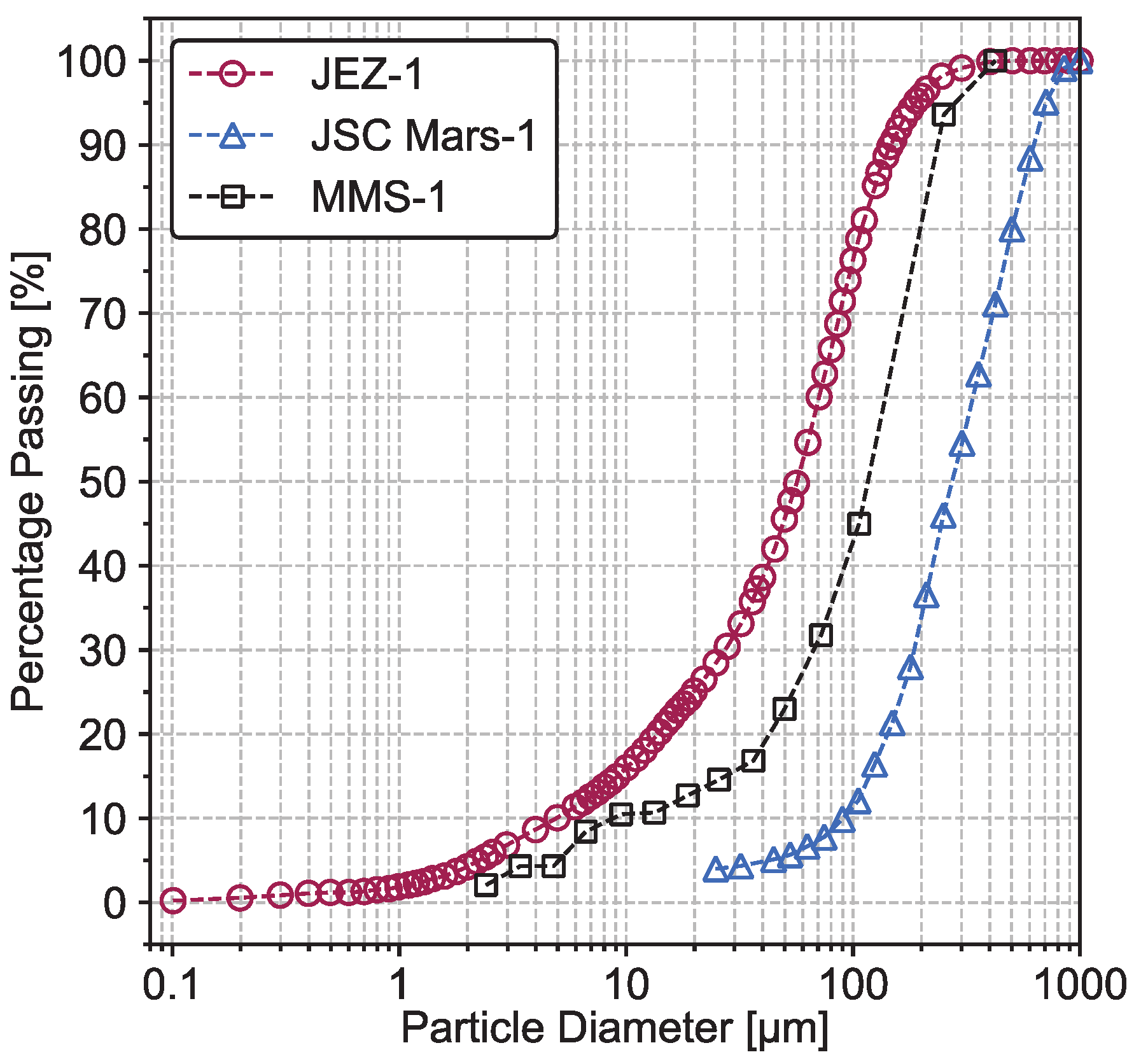
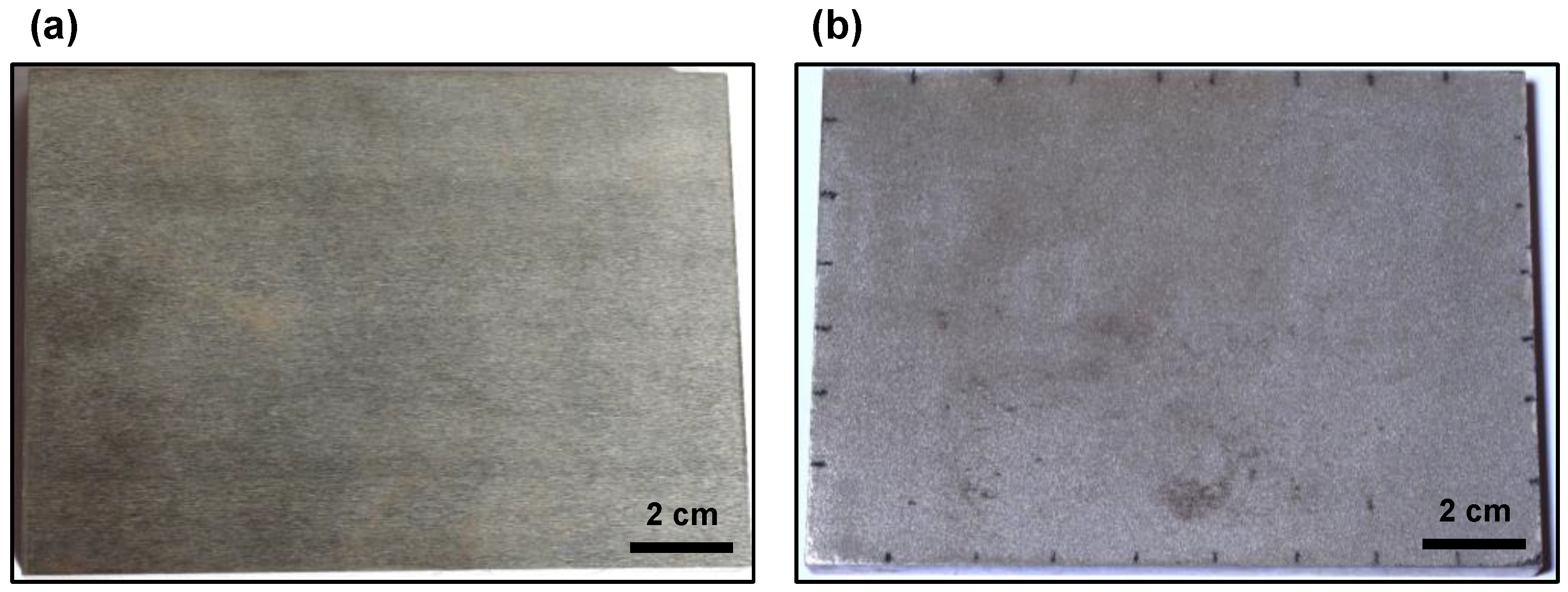
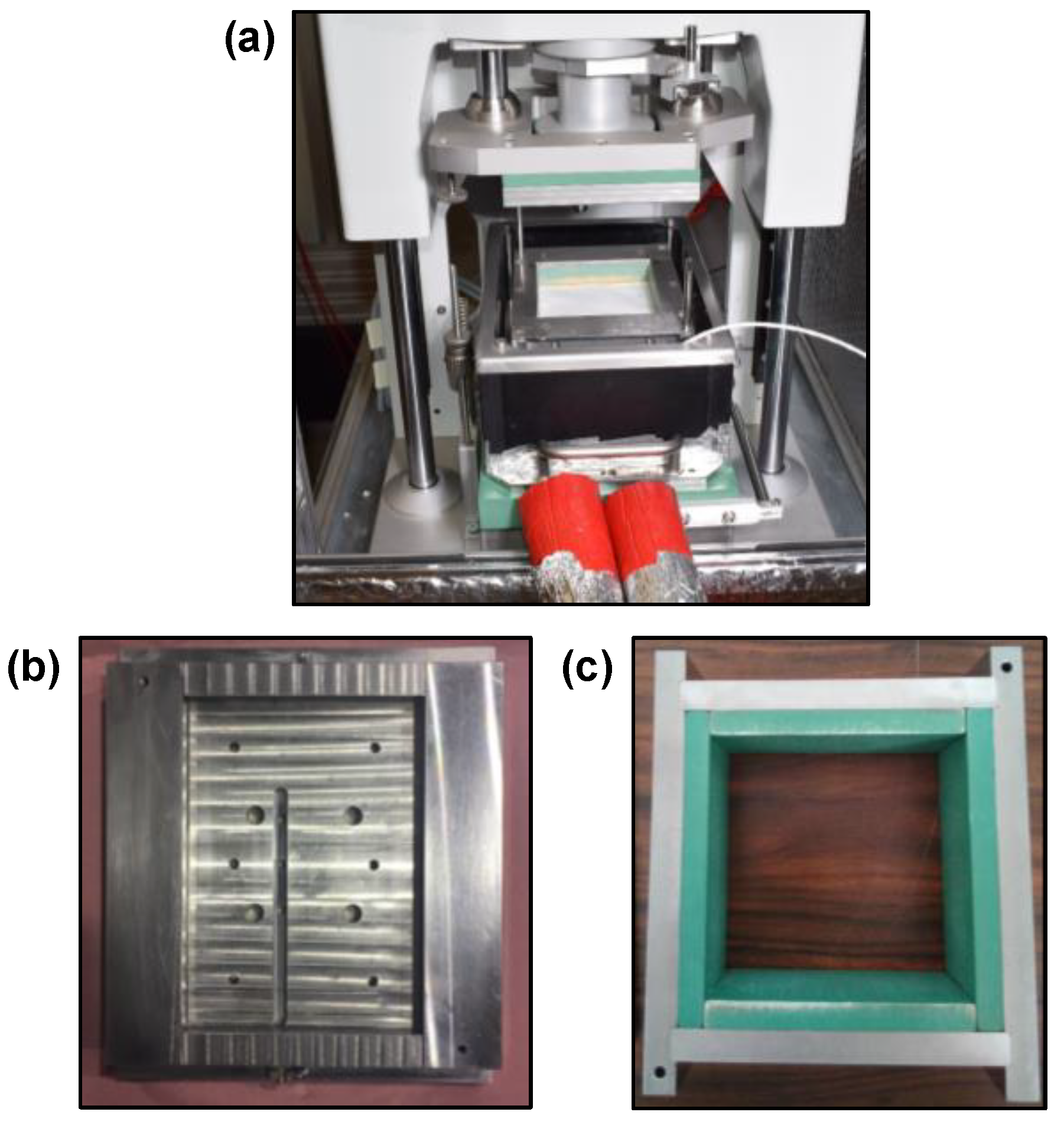
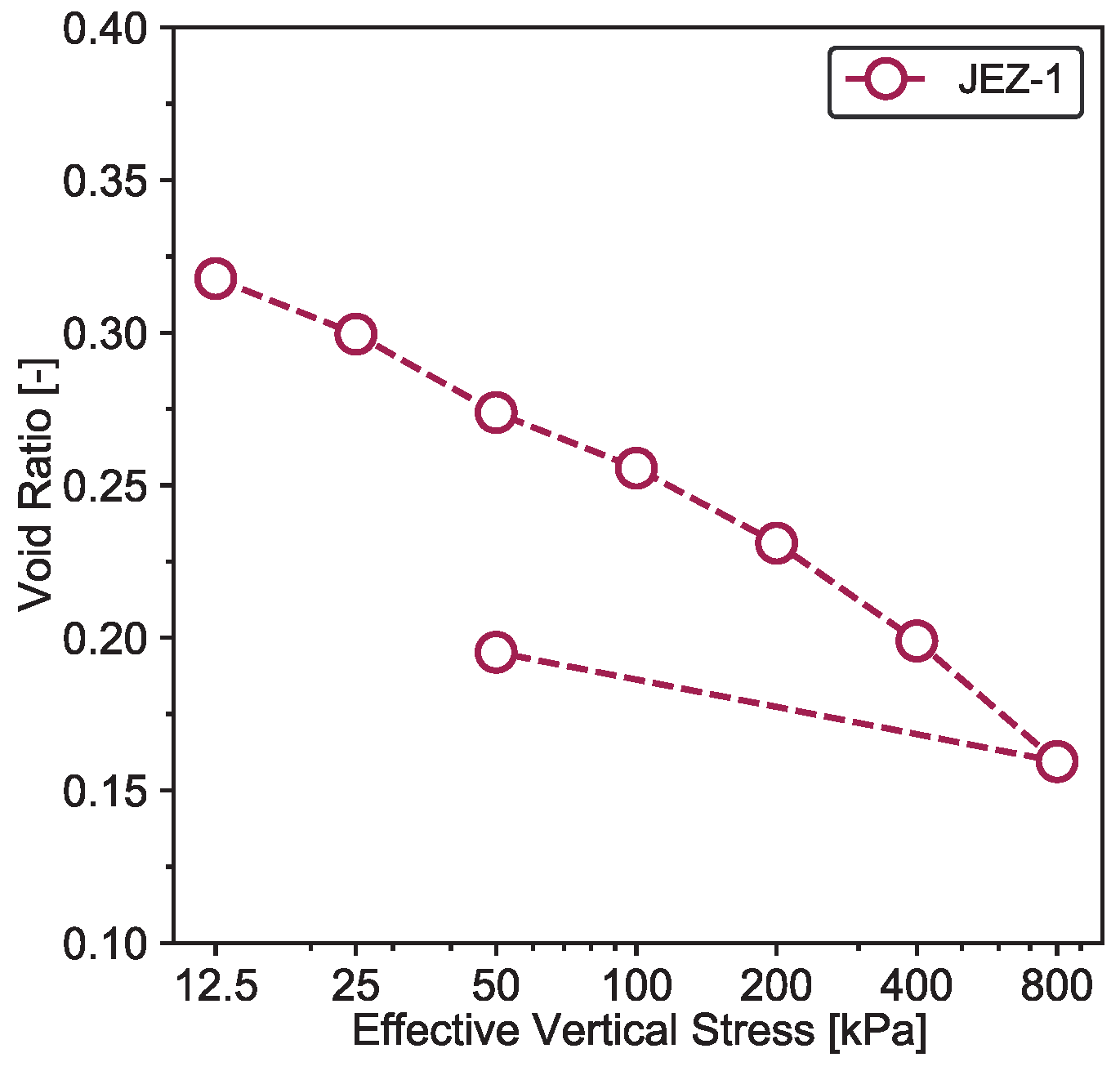
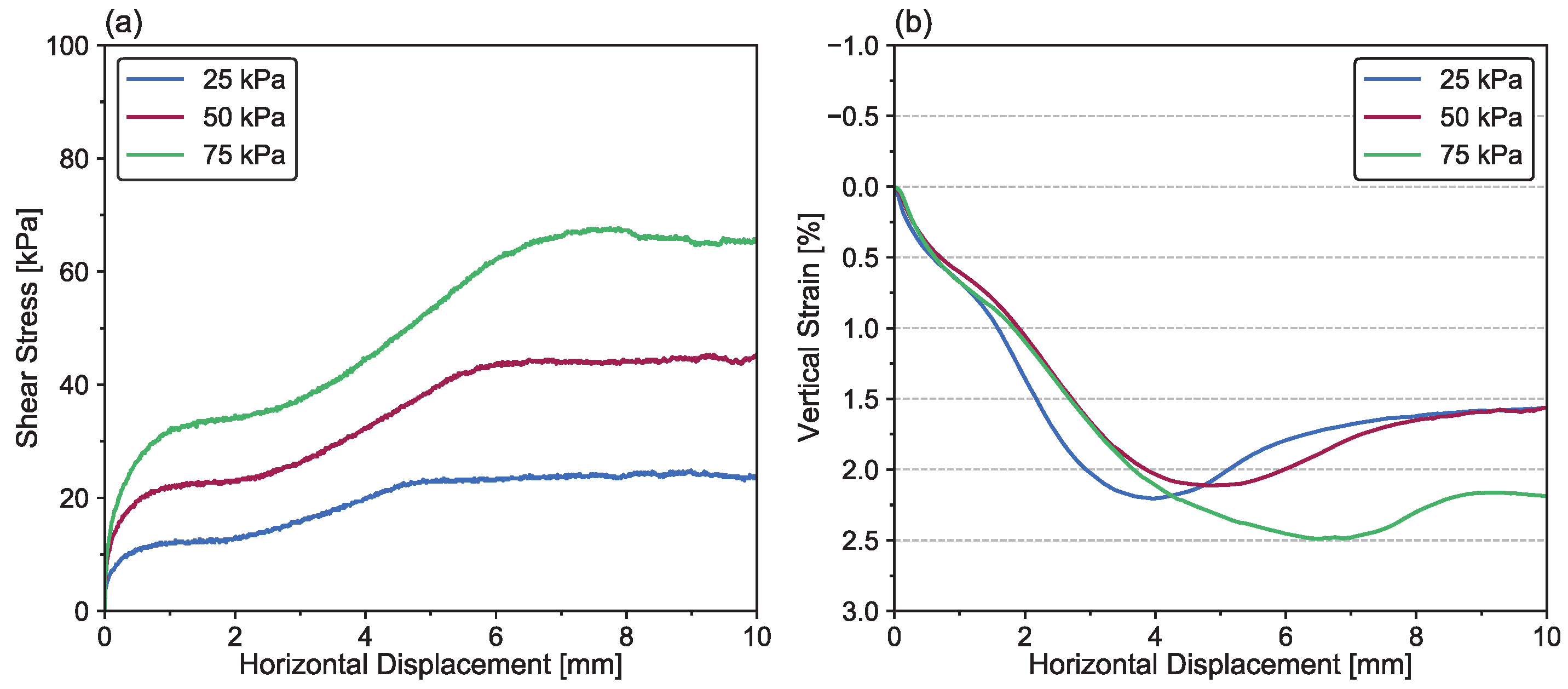
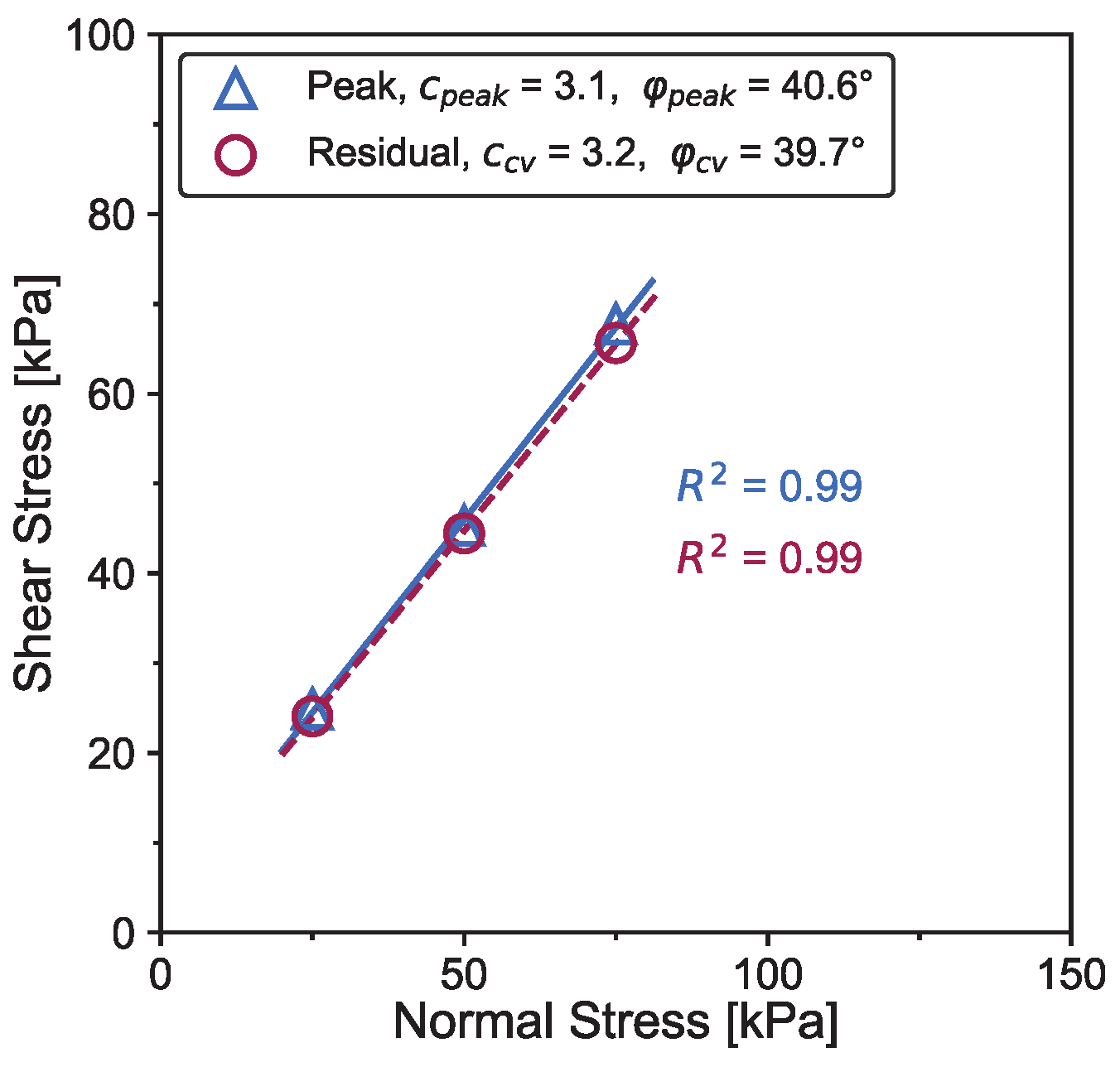
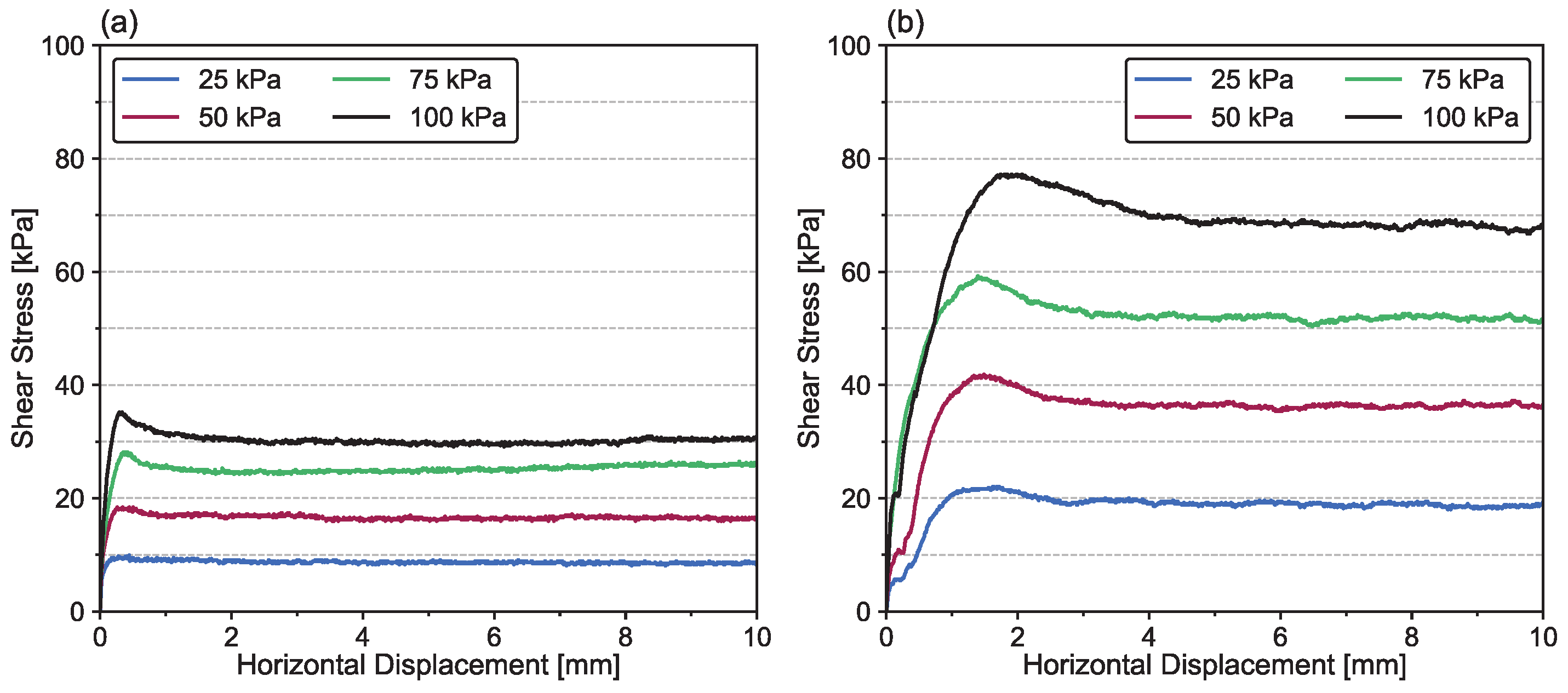
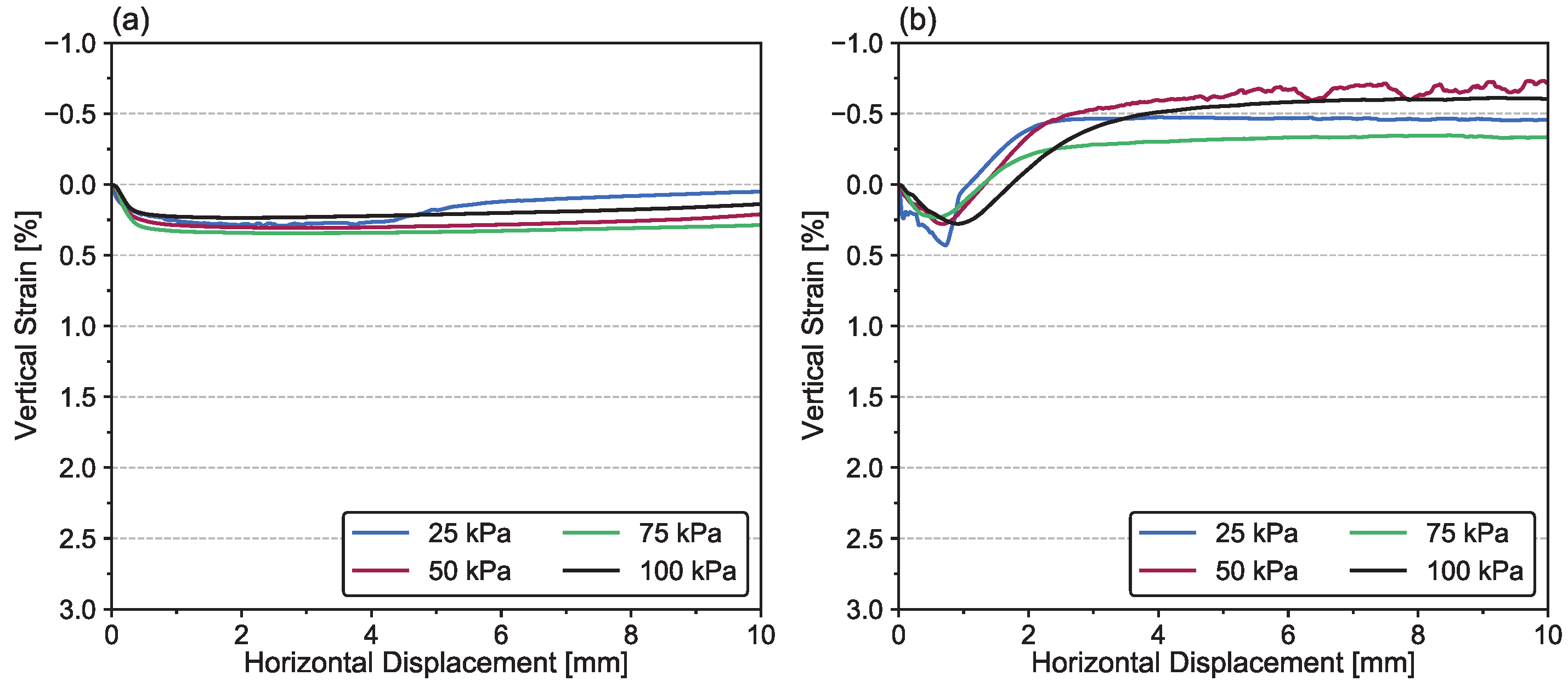
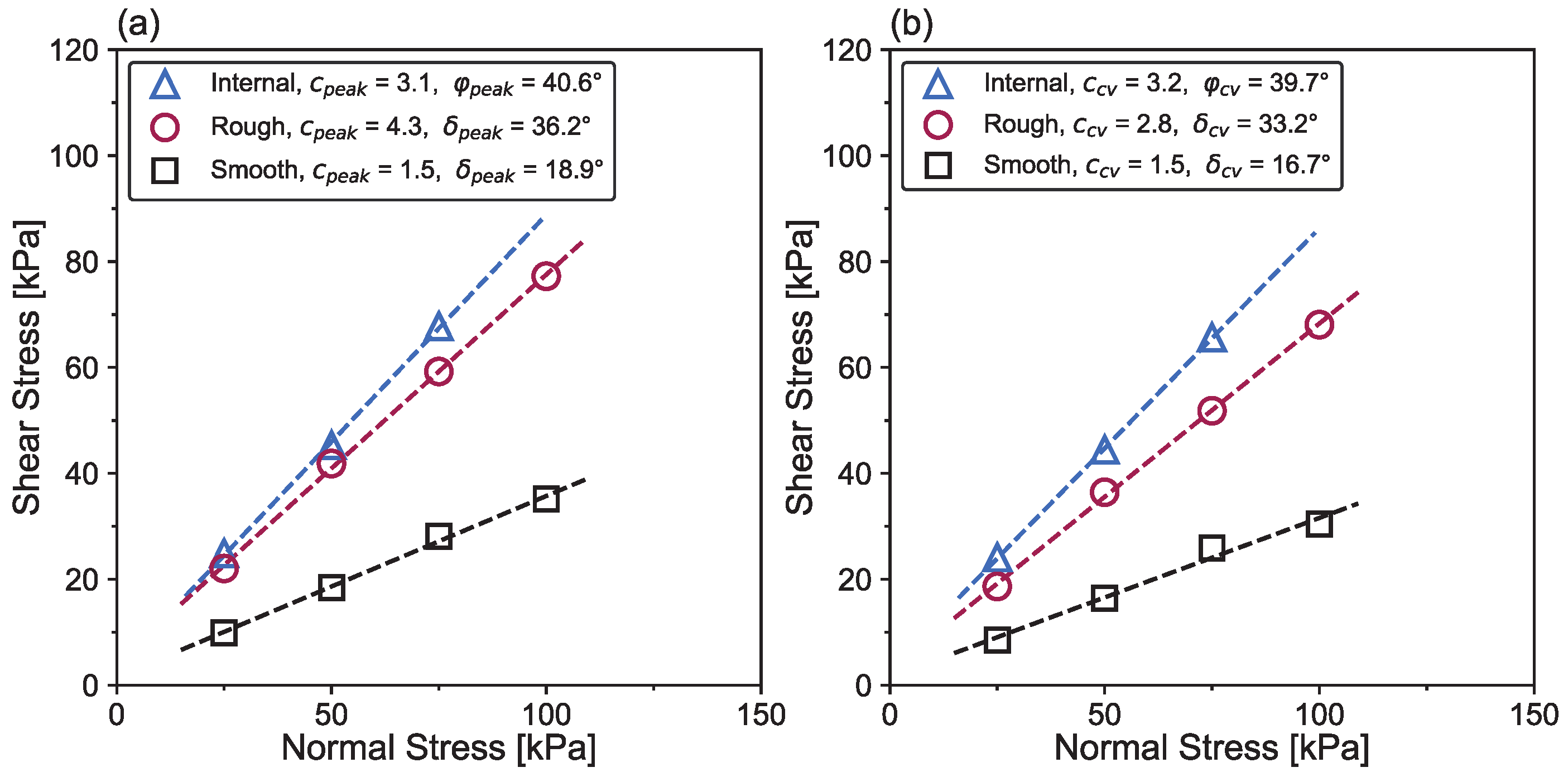
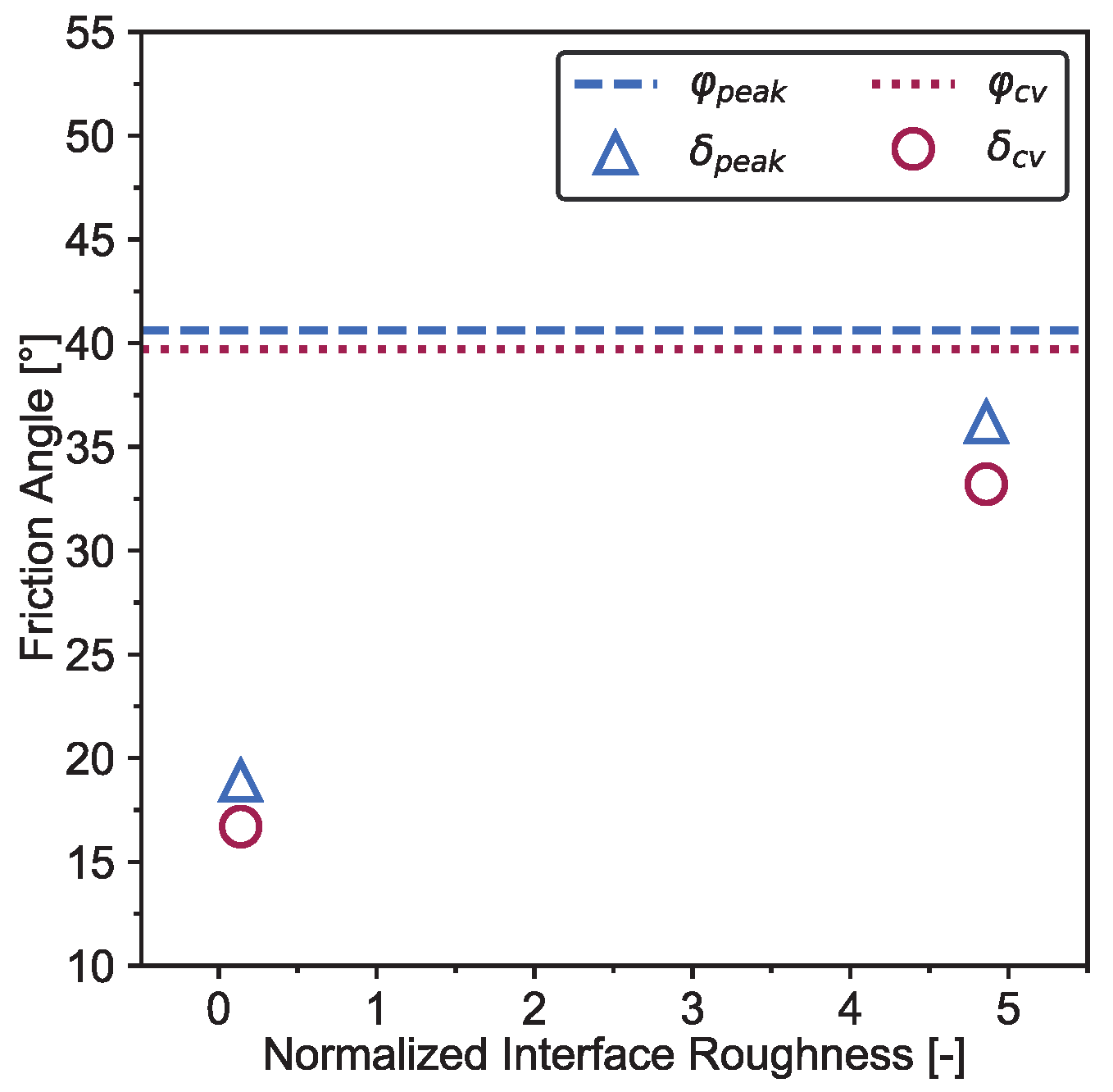
| Component | wt.% | Component | wt.% |
|---|---|---|---|
| Olivine | 32.0 | Plagioclase | 16.0 |
| Glass-rich basalt | 13.5 | Pyroxene | 12.0 |
| Mg-carbonate | 11.0 | Smectite | 6.0 |
| Mg-sulfate | 2.4 | Ferrihydrite | 2.1 |
| Hydrated silica | 1.8 | Magnetite | 1.1 |
| Anhydrite | 1.0 | Fe-carbonate | 0.8 |
| Hematite | 0.3 | - | - |
| Component | wt.% | Component | wt.% |
|---|---|---|---|
| SiO2 | 44.2 | TiO2 | 0.2 |
| Al2O3 | 11.3 | Cr2O3 | 0.3 |
| FeOT | 9.5 | MnO | 0.1 |
| MgO | 25.9 | CaO | 3.5 |
| Na2O | 1.9 | K2O | 0.3 |
| P2O5 | 0.6 | SO3 | 2.1 |
| Plate Number | Ra (μm) | Rmax (μm) | d50 (μm) | Rn (-) | Surface Rough |
|---|---|---|---|---|---|
| #1 | 1.0 | 7.9 | 57 | 0.14 | Smooth |
| #2 | 45.1 | 277 | 57 | 4.86 | Rough |
Publisher’s Note: MDPI stays neutral with regard to jurisdictional claims in published maps and institutional affiliations. |
© 2021 by the authors. Licensee MDPI, Basel, Switzerland. This article is an open access article distributed under the terms and conditions of the Creative Commons Attribution (CC BY) license (https://creativecommons.org/licenses/by/4.0/).
Share and Cite
Yin, K.; Liu, J.; Lin, J.; Vasilescu, A.-R.; Othmani, K.; Di Filippo, E. Interface Direct Shear Tests on JEZ-1 Mars Regolith Simulant. Appl. Sci. 2021, 11, 7052. https://doi.org/10.3390/app11157052
Yin K, Liu J, Lin J, Vasilescu A-R, Othmani K, Di Filippo E. Interface Direct Shear Tests on JEZ-1 Mars Regolith Simulant. Applied Sciences. 2021; 11(15):7052. https://doi.org/10.3390/app11157052
Chicago/Turabian StyleYin, Kexin, Jiangxin Liu, Jiaxing Lin, Andreea-Roxana Vasilescu, Khaoula Othmani, and Eugenia Di Filippo. 2021. "Interface Direct Shear Tests on JEZ-1 Mars Regolith Simulant" Applied Sciences 11, no. 15: 7052. https://doi.org/10.3390/app11157052
APA StyleYin, K., Liu, J., Lin, J., Vasilescu, A.-R., Othmani, K., & Di Filippo, E. (2021). Interface Direct Shear Tests on JEZ-1 Mars Regolith Simulant. Applied Sciences, 11(15), 7052. https://doi.org/10.3390/app11157052






